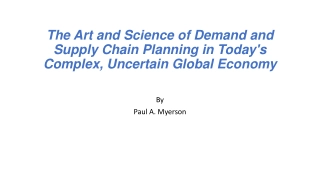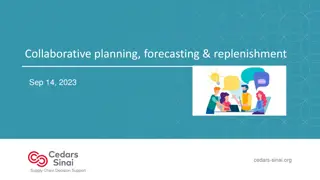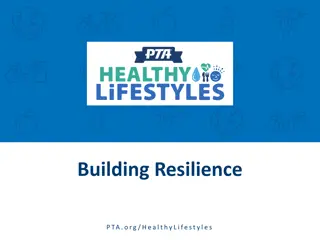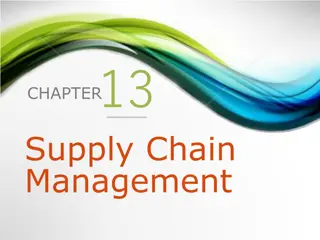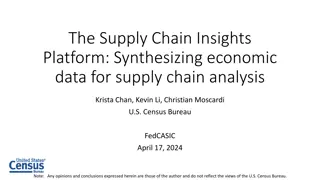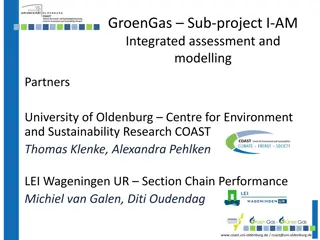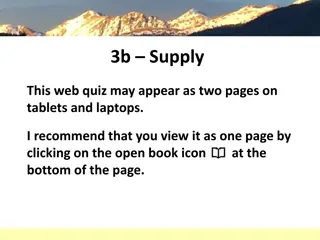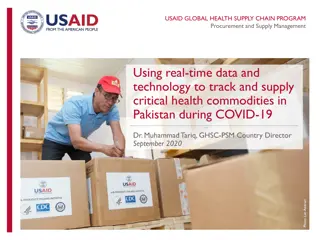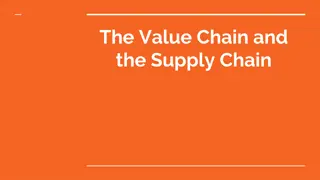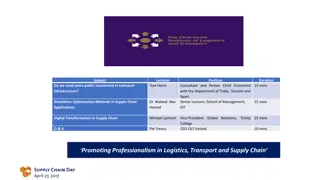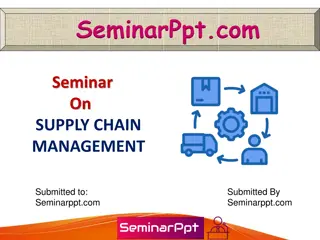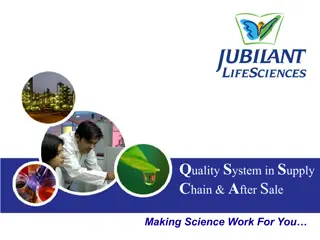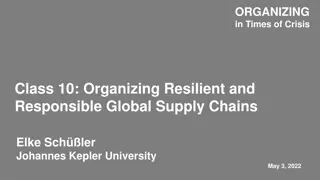
Enhancing Supply Chain Resilience Post-COVID19 and Beyond
Explore the concept of resilience in supply chains, focusing on risk management, crisis response, and operational strategies post-pandemic. Learn about building resilience through absorbing shocks and bouncing back effectively.
Download Presentation

Please find below an Image/Link to download the presentation.
The content on the website is provided AS IS for your information and personal use only. It may not be sold, licensed, or shared on other websites without obtaining consent from the author. If you encounter any issues during the download, it is possible that the publisher has removed the file from their server.
You are allowed to download the files provided on this website for personal or commercial use, subject to the condition that they are used lawfully. All files are the property of their respective owners.
The content on the website is provided AS IS for your information and personal use only. It may not be sold, licensed, or shared on other websites without obtaining consent from the author.
E N D
Presentation Transcript
Supply Chain Resilience Post Covid19 and Beyond Andy Tomkinson FBCI Wednesday 24thJune 2020
Definition of Resilience The ability to absorb shock and bounce back Absorb shock through risk controls of inherent risk Corporate Mission, vision and values, risk appetite statement, risk registers, risk treatment plan, risk based business case. Bounce back through mitigation of residual risk by effective response in sequence; Emergency response, crisis management, business continuity and disaster recovery in order to return to new normality (BAU) in the fastest possible time. Operational resilience not Organisational resilience
Two Sides of the same Resilience Coin HEADS ABSORB SHOCK INHERRENT RISK CONTROLS PREVENTION IS BETTER THAN CURE TAILS BOUNCE BACK RESIDUAL RISK RESPONSE REACT AND RECOVER
Operational Resilience; Risk and Response Threat; FIRE Target Hardening from inherent risks. Inoculation By; BAU Resumption BC/DR Reserves Alternatives Contingencies Crisis Reduce Severity; FIT SPRINKLERS Reduce Likelihood; NO SMOKING POLICY Management Emergency Response Residual Risk; FIRE EVENT DUE TO ELECTRICAL SPARK
Supply Chain Resilience The system of people, activities and commodities that are involved in getting a product or service from the place where it is made delivered to the person who wants it. Just in time Versus (No reserves; Assurance (Quality and lower cost) cost) reliability; higher
Audit 3 Lines of Defence 1st the first line of defence functions that own and manage risk 2nd the second line of defence functions that oversee or specialise in risk management, compliance 3rd the third line of defence functions that provide independent assurance, above all internal audit.
Internal Control Framework Awareness Reporting Culture Self Assurance Continual Improvement 1st Line of Defence Operational Management 2nd Line of Defence Risk Management & Compliance Board of Directors Board Risk Committee Oversight Managing Director Management Board 3rd Line of Defence Internal Audit External Audit Regulatory visit Board of Auditors Risk & Audit Committee
Internal Audit Process Agree scope Audit planning brief Request for information Fieldwork interviews Risk control matrix Draft report Final report Management actions to close out of findings
MARIO MISSION Corporate purpose, strategic intent, aim INPUTS ACTIVITIES OUTPUTS Upstream raw materials Consumables Production Customer Deliverables Functions Products and Services RESOURCES People, Premises, Processes, Providers, Punctuality, Publicity, Public Infrastructure
Latest Financial Services OR Regulations Risk based approach (OR) Customer harm Systemic effect Disruptive impact tolerance Scenario based stress testing 3rd Party dependencies (Outsourcing and Offshoring) Managed Service Partners (MSPs) and Outsourced Service Providers (OSPs)
Auditors Viewpoint; Document review & fieldwork Links in governance and oversight where Mission (Policy, risk appetite, programme, management systems are distilled down and reported up) to achieve; Risk based approach. Absorb shock and bounce back mitigates; Customer harm* Supply chain** resilience prevents; Systemic effect Disruptive impact tolerance; is accounted in the BIA (acceptable time & acceptable level) and informs the BCPs and DRPs Scenario based stress testing; Assurance and continual improvement Procurement, monitoring and Exit strategies; 3rd Party dependencies *Risk metrics previously; financial cost, reputation, regulatory sanctions, downtime etc ** Upstream 3rd, 4th, 5th parties and beyond. Downstream and Peers.
Post Covid19 and Beyond affecting Supply International Depression and Bankruptcy Brexit; Border controls, trade agreements, tariffs, import and export, EU vs UK regulations Civil Unrest with BLM protests affecting businesses (Looting, boycotts, education, law and order) Second Wave Cyber Climate Change Terrorism Traditional risks of fire, flood, explosion, blackout, weather, seasonality, False lessons learned WFH is the panacea (Mental health, InfoSec, Remote AV media, compliance, on prem retail/events)
Summary Resilience is the ability to absorb shock and bounce back Must be a risk-based approach Supply chain resilience is vital (MARIO) New regulations and evolution from BC to OR focus on Supply Document procurement, monitoring and exit strategies Stress test them in realistic scenario rehearsals Covid19 has some good lessons learned and some false positives We face risks collectively but also individually. Its much easier where we are told what to do than when we have to make our own decisions and the competition is unaffected WFH has worked well in many cases although comes with some risks and is not the panacea for operational resilience
Thank you for your time Any questions? https://www.linkedin.com/in/andytomkinson/

